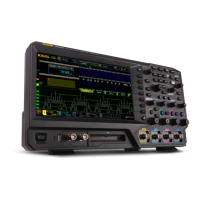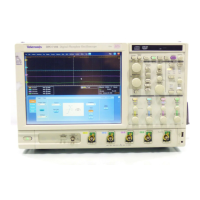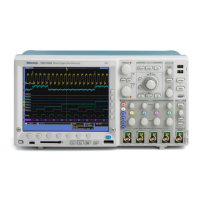Commands Listed in Alphabetical Order
acquisition o f
all channels. This a llows you to compensate for delay differences
introduced between channels by external cabling with unequal delays.
NOTE. Delay is only supported by sampling modules that include delay hardware.
Using delay instead of deskew will not affect overall acquisition performance
since multiple passes for acquisitions are not required.
Group
Vertical
Syntax
CH<x>:DELay<NR3>
CH<x>:DELay?
Arguments
NR3 is the delay time for this channel. The range is -100% to +100% with
a resolution of 0.1%.
Examples
CH7:DELAY 0.1 sets the delay for Channel 7 to 10%.
CH3:DELAY? might returnCH3:DELAY 0.250000000 indicating that the delay
time for Channel 3 is set to 25%.
CH<x>:DESkew
This command sets or queries the deskew time for the channe l specified by x,
which can be 1 through 8. Sending this command is the equivalent to setting
Deskew in the Vertical Setup dialog box for the selected channel.
You can adjust deskew to add or subtract an independent, channel-based
acquisition time d elay to the delay from the trigger point (the horizontal position)
that is inherently common to the acq
uisition of all channels. This allows you
to compensate for delay differences introduced between channels by external
cabling with unequal delays.
NOTE. Setting d ifferent deskew values on dual-channel sampling modules that
use a single sampling strobe (for example, the 80E02, 80E03, 80E04 sampling
modules) reduces overall acquisition performance. In these instances, the
acquisition must digitize eac
h channel on a separate acquisition pass to obtain
each of the signals with the desired time alignment. This multiple pass acquisition
process applies to the acquisition of the channels within each active timebase.
Group
Vertical
DSA/CSA/TDS8X00/B Series Programmer Manual 2-79

